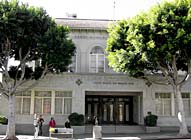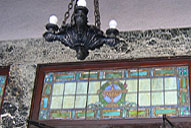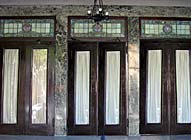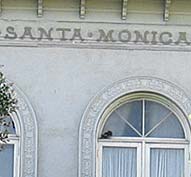




1210 Fourth St.
Architect: Henry Hollwedel


Santa Monica Bay Woman’s Club

Interior detail

Doorway

Exterior detail
The two-story Classical Revival building is sheathed in stucco. Its tiled hip roof has bracketed eaves and a decorated frieze. Six arched casement windows with decorated surrounds and topped by fan lights span the second floor façade. The first floor has a wide inset entrance in the center flanked by triple rectangular casement windows with transoms and stained glass over each doorway. The glazed triple entry is framed by oak set into marble.
The architect of this poignant structure on Fourth Street just south of Wilshire Boulevard, was Henry C. Hollwedel, who also designed the Mayfair Theater on Santa Monica Boulevard and Henshey’s Department Store at Fourth and Santa Monica Boulevard. All three of the buildings were subsequently designated landmarks by the City of Santa Monica, but the Women’s Club is the only one of the three that is still intact. Henshey’s was demolished to make way for Toys ‘R Us, and the Mayfair’s future has been in question since the Northridge Earthquake, January 17, 1994.
Hollwedel is noteworthy for both his professional and civic contributions to Santa Monica in the early part of the century. He was a member of the Santa Monica Board of Trade and served as the city building inspector. As an inspector, he guided the construction of the Santa Monica Pier.
The Santa Monica Bay Women’s Club Classical Revival architecture
is based on a design movement that believed in the use of pure Roman and
Greek forms.
Federal government buildings of the first half of the 20th century, such
as the Capitol Building in Washington, D.C., owe much to this Beaux-Arts
interpretation of classical design, as does Thomas Jefferson’s Monticello.
In the late 19th and early 20th centuries, commissions for public buildings
and grand houses of industrial moguls went to architects trained in the
Beaux-Arts Classical Revival tradition. These architects produced academic
designs based on classical or Renaissance features such as symmetrically
arranged buildings with smooth surfaces based on simple geometric forms
expanded to monumental proportions. Porticos are supported by a series
of pilasters, and windows tend to be large single-light sashes.